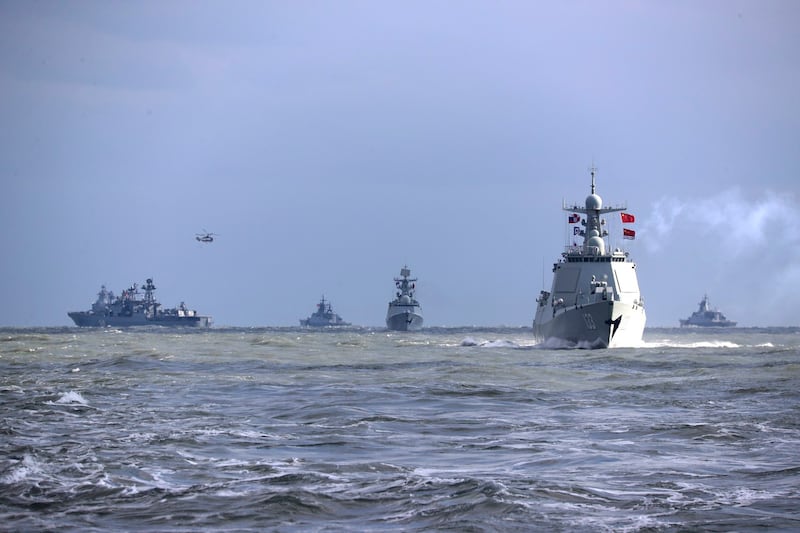The Chinese aircraft carrier Liaoning made a rare approach to the U.S. island territory of Guam in what a Chinese newspaper interpreted as a warning to the U.S. over Taiwan.
The Liaoning and its escorting vessels have been conducting drills in the West Pacific since mid-December, when Japan announced its new security strategy that named China as an unprecedented “strategic challenge.”
The Japanese Ministry of Defense's Joint Staff Office said in a statement on Wednesday that during ten days from Dec. 17 to Dec. 27, Chinese carrier-based aircraft conducted a total of about 260 take-offs and landings, prompting Japan to scramble military aircraft and vessels.
The Chinese fleet, consisting of the Liaoning, one Type 055 large missile destroyer and a number of other vessels, was sailing near the remote Okinawa Prefecture islands of Okidaito and Kitadaito, but also near Okinotorishima, the southernmost part of Japan.
The statement said on Dec. 25 the Liaoning was spotted 670 kilometers (416 miles) southeast of Okinotorishima, about 618 km (384 miles) northwest of Guam, before returning to the waters between Taiwan and Japan.
Guam is home to two key U.S. military bases hosting strategic bombers and submarines.
By approaching Guam, the People’s Liberation Army (PLA) has extended its reach well beyond the so-called First Island Chain onto the Second Island Chain.
The First Island Chain is a chain of main archipelagos surrounding the East Asian continental mainland, including Japan and Taiwan.
Threat to Guam?
The Liaoning's operation "showed that the Chinese carrier is ready to defend the country against potential U.S. attacks launched from there, including military interference attempts over the Taiwan question," said the Global Times, a sister publication of the Chinese Communist Party's mouthpiece People's Daily.
“The U.S. is building a group of military bases in Guam, Japan and Australia targeting China, with Guam being a core forward operating base featuring all types of military services,” it quoted Chinese military analysts as saying, adding that Guam is considered “an important node in the Second Island Chain that is designed to contain China.”
In June 2019, the Liaoning also approached Guam as an apparent response to U.S. military exercises with its allies in the region at the time.
“This deployment should be seen as a reflection of the PLA thinking about Guam's importance to U.S. operations,” said Carl Schuster, a retired U.S. Navy captain and former director of operations at the U.S. Pacific Command's Joint Intelligence Center.
“It is also a harbinger of future PLA Navy plans and operations, particularly when more capable platforms are in service,” Schuster said.
“The geo-political and strategic signal being sent is: "We can and may reach you. If not today, then soon," the analyst added.
Schuster argued that the Liaoning, as China’s first aircraft carrier and one saddled with an obsolete design, “serves primarily as a doctrinal development and experimentation but also as an operational test and training platform.”
The Liaoning's carrier group includes ships equipped with long-range land attack cruise missiles that can strike Guam from several hundred nautical miles away.
“More importantly, the coming Type 003 aircraft carriers will have greater striking power than the Liaoning and if employed in combination with air, surface and subsurface-launched missiles and perhaps ballistic missiles, will pose a significant threat to Guam,” the analyst told RFA.

Taiwan issue
On Sunday the PLA Eastern Theater Command conducted a “joint combat-readiness security patrol and joint firepower striking exercise” around Taiwan.
These "military actions by the PLA are targeted at 'Taiwan independence' separatist forces and external interferences, aiming to defend national sovereignty and territorial integrity," Senior Col. Tan Kefei, spokesman for the Chinese Ministry of National Defense, told a press briefing on Thursday.
“Since the PLA has been focusing on training as a system, it cannot be ruled out that the Liaoning aircraft carrier group's far sea exercise was interrelated with the drills around the island of Taiwan,” the Global Times quoted an anonymous Chinese military expert as saying.
The current operation by the Liaoning carrier strike group includes drills “simulating missile launches targeting islands in the Nansei chain”. It was ordered by China’s paramount leader Xi Jinping “to undermine Japan’s security strategy against China,” according to Japanese newspaper the Yomiuri Shimbun
The Nansei (Ryukyu) islands are an island chain stretching southwest from the Japanese prefectures of Kagoshima and Okinawa toward Taiwan. The operation therefore can also be considered as a message of warning against any support that Japan may extend to the self-ruled island that Beijing considers a breakaway Chinese province.
This year has witnessed increased U.S.-China tensions over Taiwan, especially after the visit by U.S. House Speaker Nancy Pelosi to Taipei in early August.
Last week President Joe Biden signed into law a defense bill, in which the U.S. is to loan the democratic island U.S.$2 billion to bolster its capabilities against threats from China.
The move angered Beijing which called it “a serious political provocation against China.”
